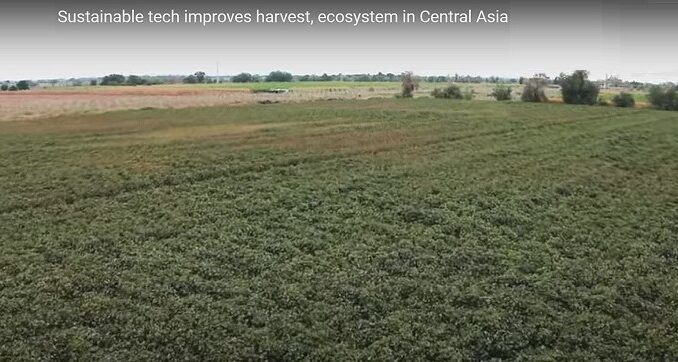
Greening the Silk Road: China’s contributes sustainable water saving technology to improve harvest and ecosystem in Central Asia’s Aral Sea
Once the world’s fourth-largest lake, the Aral Sea, located between Kazakhstan and Uzbekistan, has shrunk remarkably since 1960 — with its surface area dwindling from 67,000 square km in 1960 to just 6,000 in 2020. Farmland expansion, rising temperatures and a lack of water-saving technology caused the sea to shrink to just 10 percent of its original surface by the end of the 1990s. The exposed lake bed has been a main source of salt and associated health problems, as well as dust storms.
After nearly five years of cooperation, Chinese and Uzbek scientists found out that increased evaporation caused by rising temperatures is a key factor in the Aral Sea crisis. They then proposed the adoption of a water-saving technology as a solution to restore the lake.
In recent years, China has contributed technology and experience to monitor and improve the ecology of Central Asia countries, turning the dream of a “Green Silk Road” into reality. Scientists from the Xinjiang Institute of Ecology and Geography (XIEG) under the Chinese Academy of Sciences and Uzbekistan have been actively cooperating on the treatment of the Aral Sea.
“The Aral Sea crisis is essentially a problem of an inland lake drying up due to excessive water extraction for agricultural irrigation”
Li Yaoming, director, Research Center for Green Development of Silk Road at XIEG
Large areas of the lake bed have become bare and covered with salt or salt crust. The health of local residents has also been affected, with a significant increase in the proportion of people suffering from leukemia, kidney disease, bronchitis, and asthma.
“China’s Xinjiang region has also faced similar problems in the past, such as the management of the Tarim River. China has been implementing ecological water transfer from the Tarim River for many years and has relatively mature water resource management techniques, which can provide a reference for Uzbekistan,” said Li.
In the suburb of Tashkent, capital of Uzbekistan, stood a 5-hectare demonstration field for drip irrigation water-saving technology. XIEG participated in the project, established an observation station for plants, brought cotton and wheat seeds from China and used drip irrigation to improve plant productivity.
The drip irrigation technology equipment and supporting farming machinery here are all from China, according to Shakhzod Saitjanov, a research fellow from the Institute of Genetics and Plant Experimental Biology of the Academy of Science of Uzbekistan. He believes this project will elevate the quality of Uzbekistan’s agriculture and boost the country’s economy.
Traditionally, Uzbeks tended to use flood irrigation in cotton cultivation, which requires the use of a large amount of water. We have introduced new drip irrigation technology, which will save a significant amount of water resources, said Li.
The institute helped develop an integrated water-saving irrigation system for cotton in the Aral Sea region and a 25-hectare technology demonstration base has been established. In 2021 and 2022, Uzbekistan found out that yields reached 404 kilograms and 414 kilograms per mu (0.06 hectare), respectively, while the water-saving rate reached 70 percent. Both yield and water-saving efficiency were more than double that of local cotton fields.
In addition, Chinese scientists also helped in improving and managing saline-alkali land. They use salt-tolerant plants to reduce the salt content in the soil, creating conditions for growing other crops. Artificial forests are also planted on the sandy desert that formed after the drying up of part of the Aral Sea. All of these efforts play an important role in the protection of the Aral Sea.
As the Earth is becoming hotter from global warming, inland and hydropenic Central Asian countries are facing severe environmental challenges. Such challenges are pushing China and Central Asia closer in cooperation in improving the region’s ecological problems after the Belt and Road Initiative (BRI) was launched.
Ten years ago, people in Central Asia had little understanding of China’s water-saving and ecological protection technology. However, climate change has made them feel the urgency of environmental protection in recent years, said Li, noting that more and more research institutes and government departments in Central Asian countries have been approaching them, seeking cooperation.
He said that ecological protection has been gradually emphasized under the framework of the Belt and Road Initiative and that he expects the governments of Central Asian countries provide more support to relevant projects.
Sources:
- Chinese Academy of Sciences, Dec 04, 2023. https://english.cas.cn/newsroom/cas_media/202312/t20231204_653540.shtml
- CGTN, Dec 2, 2023. https://news.cgtn.com/news/2023-12-02/China-contributes-water-saving-technology-to-protecting-the-Aral-Sea-1pcRw4q6WM8/index.html
- Xinhua, Sept 23, 2023. https://english.news.cn/20230923/03b6ead6f6b048778f25b7e5b75bd939/c.html